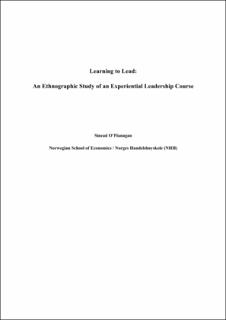| dc.description.abstract | It is widely accepted that leaders learn from experience (Day, 2010; Klimoski & Amos,
2012; Kolb, 1984; McCall, 2004, 2010a). However, learning experiences that are too
challenging or that lack a sense of safety, can overwhelm leaders and defeat the intended
purpose (McCall & Hollenbeck, 2008; Noe, Tews, & McConnell Dachner, 2010).
This study attempts to address this apparent paradox, by looking at how leaders learn in
situations where disruption, uncertainty and unpredictability prevail. The research site is a
highly popular leadership course, running for over 30 years at an elite US University. The
course is known for leaving a lasting impression on students and for having a highly charged
classroom atmosphere in which significant levels of disorientation and chaos are purportedly
present (Parks, 2005).
The author undertakes an ethnographic approach to studying the class, focusing on
presenting detailed student accounts of their experiences (Van Maanen, 1988, 2011; Yanow,
2009). The purpose is to explore how students experience this disruptive environment and
how they purportedly learn to lead in the context of this course.
During the study, the author identified Lewin (1947)/ Schein (1993, 2010a) model of
change as the theoretical lens most suited to explaining and illustrating what takes place in
this potentially disruptive learning environment. Using an interpretation of the model,
together with the student accounts of their experiences, the author identifies how learning
purportedly takes place.
The study highlights the interdependence between learners and teaching faculty, as well
as amongst learners themselves, when attempting to learn about leadership. The findings
show that the continual interaction between students when levels of disequilibrium are high,
results in some students attempting to learn in situations they might otherwise consider
unsafe for inter-personal risk taking (Edmondson, 1999).
The study highlights the learning conditions present in this leadership course, which
can foster long term and provide enhanced learning opportunities for all students. The study
also points to the limitations of the teaching approach, but concludes that learning institutions
can do more to hone the learning experiences so leaders can learn from disruptive encounters | en_US |
